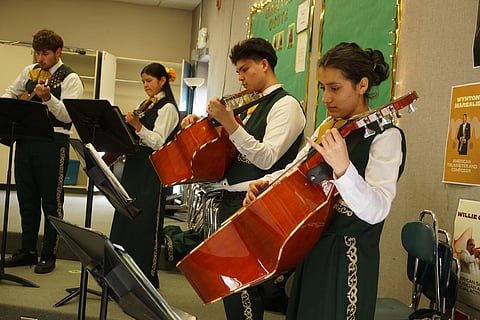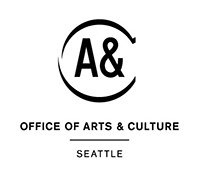Highline School District Mariachi Program Heads to the 25th Annual Mariachi Northwest Festival
A little more than a dozen teens are standing ready for class to start in the Evergreen High School music room. Their teacher, Gabriela Olivarez, addresses a question with one student while the others look over their sheet music. Some of them are holding violins, others trumpets, and others a barrel-bodied guitar known as a guitarrón.
"OK, amigos," Olivarez says as she gets her students' attention to begin practice.
This is not a band class. This is not an orchestra. This is mariachi.
Highline School District first piloted its mariachi music program during the 2023–2024 school year. The program has quickly become a community favorite at the participating schools, which include Highline High School, Evergreen High School, and Cascade Middle School. Later this week, the mariachi program will travel to the 25th annual Mariachi Northwest Festival in Wenatchee. Students will not only get a chance to work on their music skills but also perform as an ensemble during the three-day affair.
At the festival, the students will "be learning a piece together with a clinician, then the students will be separated [into instrument-specific groups] for a few sessions in the day so that they can get a better understanding of their instrument, especially when it comes to mariachi techniques," says Olivarez, who is one of three mariachi music teachers in the district.
During Evergreen High School's mariachi class, the students practice many songs, working on specific parts as opposed to playing through the whole song.
The class's setlist includes classics, such as "Amor Eterno," written by Mexican icon Juan Gabriel (primarily known for being performed by Rocío Dúrcal); the mariachi national anthem "Son de la Negra"; José Alfredo Jiménez's "El Rey" (a song whose rendition by Mexican songbird Vicente Fernández is widely known); and Miguel Aceves Mejía's "Los Laureles."
Students take turns singing, too.
"When they enroll in this class, they know that they have two instruments — their main instrument that they're playing and their voice," says Olivarez, who was previously a choir teacher.
For 11th grader Edgar Davalos, mariachi was his gateway into singing.
"While my mom was driving, she would hear me sing and say, 'You sing pretty good, why don't you join choir?'" Davalos says, adding that he was too shy to try out.
Eventually, he found his voice in mariachi. He especially loves singing "Acá Entre Nos" and "Un Millon de Primaveras" by Vicente Fernández.
The first time his mother heard him sing at a mariachi school event, he saw her holding back tears as he sang in her direction. Davalos says the program has helped him further connect with his culture and his family.
Olivarez says many of her students feel this is the first time they see their culture explored or displayed in this kind of school setting.
"That's not really something that we see in traditional American music programs like band, orchestra, or choir, which is a lot of Westernized music, like old dead white guy music," she says jokingly. "So for them, playing music by Vicente or Juan Gabriel is really touching."
Olivarez spearheaded the program last year with two other teachers, but she has been working as the district's music specialist for the past eight years. Evergreen's principal had approached her about a mariachi program a few years back. Oliveras fit the bill well. A young Latina herself, she says building the program has helped her connect with a part of her identity she never had a chance to acknowledge as well.
"My mother is from Barranquilla, Colombia, and my dad is Mexican American," Olivarez says in Spanish, "I grew up listening more to Colombian music. … My dad grew up in the '50s in Kansas City, went to segregated school, and was not able to learn his mother tongue because he was forbidden; a lot of immigrants assimilated to survive."
While most students involved in mariachi are of Mexican heritage, the class is open to anyone and is fairly diverse, with Vietnamese, white, and Polynesian students participating as well.
"As a Vietnamese person, I came in, like, really blind," explains Han Nguyen, a senior at Evergreen High School. She says she joined mainly because of her admiration for Olivarez's passion for music and teaching. Nguyen soon learned that mariachi could be inclusive of many cultures.
"I have no personal connection to mariachi; it wasn't until a couple months into the program we pulled out a bolero song and that's where I started getting excited, because in Vietnamese culture, we have bolero as well. It was a huge bridge."
The principal also suggested the program because of feedback and interest from the surrounding community.
"There was a mariachi program at Chief Sealth … and Chief Sealth is in our neighborhood," Olivarez explained. "It's just right down the street from us, and a lot of our students and families were just hearing about that and were asking."
Olivarez is quick to point out that the district has a large Latino population. In fact, the district demographics lean Latino. As its largest demographic, Latinos represent almost 40% of the student body. This may explain why the program is so popular.
"What we've learned in the past two years of having mariachi is just there's a lot of community investment and involvement. The families want to be there, they're at our concerts, [and] the students, I've never had a group of students so invested in their music program," she says.
According to Olivarez, students involved in the program are proud to wear their "trajes de charro," their traditional mariachi garb. The suits and bows coincide with each school's colors and are ordered directly from a Mexican vendor.
The participating schools host a "Noche de Mariachi" event twice a year. For some of the schools, it is the biggest night of the year. Students and families show up in droves to indulge in music, food, and artisan vendors. Beyond their school events, the mariachi teens are also getting requested for private events, such as corporate meetings and quinceañeras. According to Olivarez, they've had to put limits on the number of shows they can do since they get asked at least four times a month to do gigs. During their pilot year, each of the three schools' student mariachi bands did around 14 performances between April and June.
Highline's mariachi program is one of only a handful of mariachi programs in the state. Currently, according to Olivarez, 150 students are signed up for the mariachi elective across the three schools.
In light of the current presidential administration's threat against funding education programs that are perceived to embrace diversity, equity, and inclusion, Highline's superintendent, Ivan Duran, said in an email, "Programs that reflect the diverse backgrounds of our students are not political — they are essential to student success. Music has always been a unifying force, and mariachi is a perfect example of how we can celebrate cultural traditions while fostering academic engagement."
Tove Tupper, the district's chief communications officer, said in an email that the district plans to expand the program to more schools next year.
The Emerald's arts coverage is supported in part with funding from 4 Culture and the City of Seattle's Office of Arts & Culture. The Emerald maintains editorial control over its coverage.
Help keep BIPOC-led, community-powered journalism free — become a Rainmaker today.




